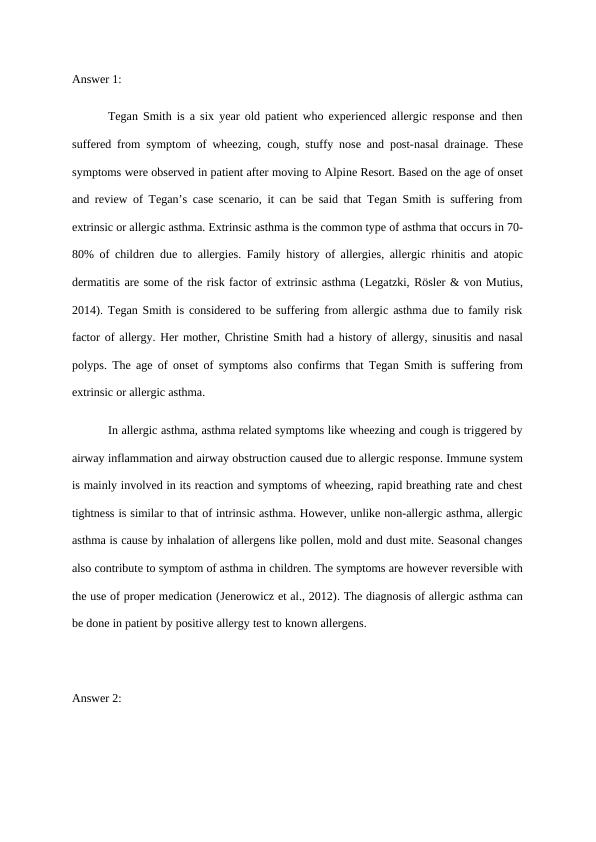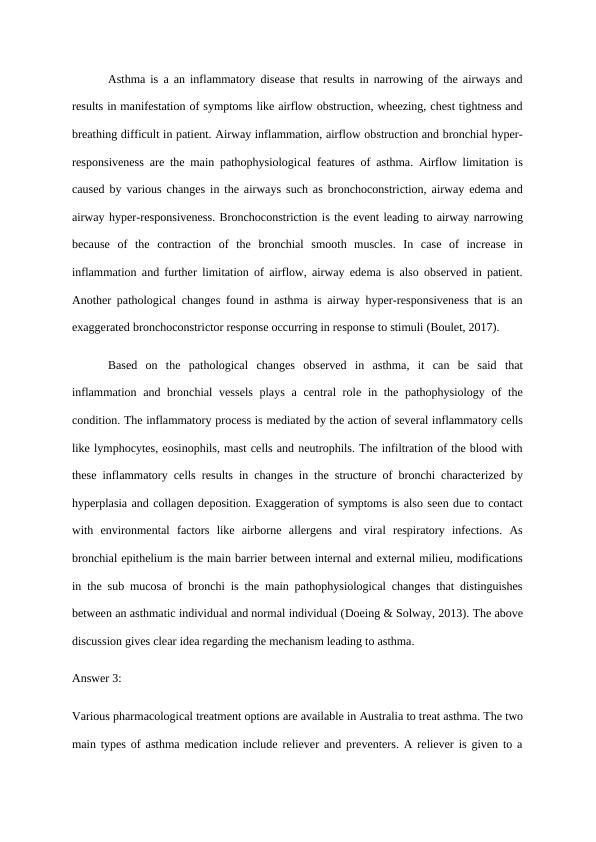Sample Assignment on Allergic
Added on 2021-05-31
5 Pages1417 Words38 Views
Answer 1:Tegan Smith is a six year old patient who experienced allergic response and thensuffered from symptom of wheezing, cough, stuffy nose and post-nasal drainage. Thesesymptoms were observed in patient after moving to Alpine Resort. Based on the age of onsetand review of Tegan’s case scenario, it can be said that Tegan Smith is suffering fromextrinsic or allergic asthma. Extrinsic asthma is the common type of asthma that occurs in 70-80% of children due to allergies. Family history of allergies, allergic rhinitis and atopicdermatitis are some of the risk factor of extrinsic asthma (Legatzki, Rösler & von Mutius,2014). Tegan Smith is considered to be suffering from allergic asthma due to family riskfactor of allergy. Her mother, Christine Smith had a history of allergy, sinusitis and nasalpolyps. The age of onset of symptoms also confirms that Tegan Smith is suffering fromextrinsic or allergic asthma. In allergic asthma, asthma related symptoms like wheezing and cough is triggered byairway inflammation and airway obstruction caused due to allergic response. Immune systemis mainly involved in its reaction and symptoms of wheezing, rapid breathing rate and chesttightness is similar to that of intrinsic asthma. However, unlike non-allergic asthma, allergicasthma is cause by inhalation of allergens like pollen, mold and dust mite. Seasonal changesalso contribute to symptom of asthma in children. The symptoms are however reversible withthe use of proper medication (Jenerowicz et al., 2012). The diagnosis of allergic asthma canbe done in patient by positive allergy test to known allergens. Answer 2:

Asthma is a an inflammatory disease that results in narrowing of the airways andresults in manifestation of symptoms like airflow obstruction, wheezing, chest tightness andbreathing difficult in patient. Airway inflammation, airflow obstruction and bronchial hyper-responsiveness are the main pathophysiological features of asthma. Airflow limitation iscaused by various changes in the airways such as bronchoconstriction, airway edema andairway hyper-responsiveness. Bronchoconstriction is the event leading to airway narrowingbecause of the contraction of the bronchial smooth muscles. In case of increase ininflammation and further limitation of airflow, airway edema is also observed in patient.Another pathological changes found in asthma is airway hyper-responsiveness that is anexaggerated bronchoconstrictor response occurring in response to stimuli (Boulet, 2017).Based on the pathological changes observed in asthma, it can be said thatinflammation and bronchial vessels plays a central role in the pathophysiology of thecondition. The inflammatory process is mediated by the action of several inflammatory cellslike lymphocytes, eosinophils, mast cells and neutrophils. The infiltration of the blood withthese inflammatory cells results in changes in the structure of bronchi characterized byhyperplasia and collagen deposition. Exaggeration of symptoms is also seen due to contactwith environmental factors like airborne allergens and viral respiratory infections. Asbronchial epithelium is the main barrier between internal and external milieu, modificationsin the sub mucosa of bronchi is the main pathophysiological changes that distinguishesbetween an asthmatic individual and normal individual (Doeing & Solway, 2013). The abovediscussion gives clear idea regarding the mechanism leading to asthma. Answer 3:Various pharmacological treatment options are available in Australia to treat asthma. The twomain types of asthma medication include reliever and preventers. A reliever is given to a

End of preview
Want to access all the pages? Upload your documents or become a member.
Related Documents
Tegan Smith may be suffering from allergic asthmalg...
|7
|1476
|315
Case Study on Tegan Smithlg...
|6
|1426
|75
Asthma Management - Assignmentlg...
|7
|1545
|45
The Bronchial asthma managementlg...
|6
|1475
|237
Understanding Allergic Asthma: Pathophysiology, Treatment and Educationlg...
|7
|1690
|115
Case study on Respiratory System PDFlg...
|7
|1888
|266
